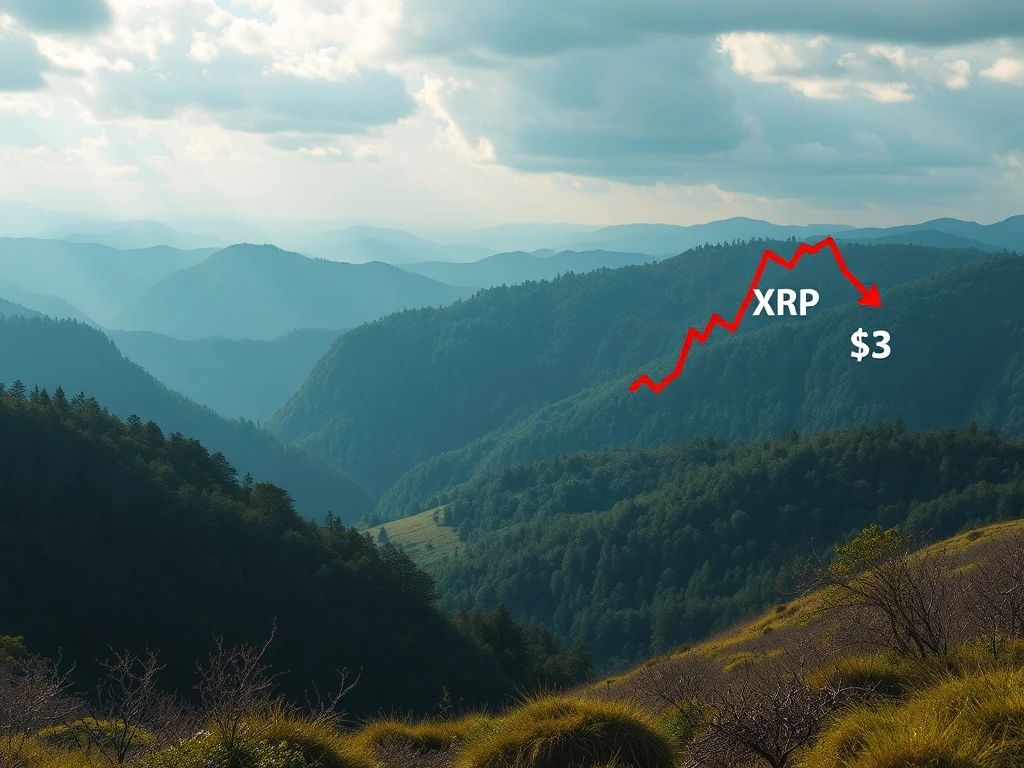For investors and traders in the cryptocurrency market, understanding key price levels is paramount. Currently, the XRP price is at a pivotal point, signaling potential trouble for bullish sentiment. Low demand-side volume and weakening price technicals suggest that bulls face a significant challenge. They must quickly reclaim the crucial $3 support level, or XRP could face a deeper and more prolonged correction.
XRP Price Faces Critical Juncture at $3
The XRP price recently experienced a notable decline, dropping approximately 5% over the last 24 hours to trade around $2.97. This movement has pushed XRP below the psychologically significant $3 level. Historically, this threshold has proven vital for XRP’s market trajectory. For instance, a high-volume close below $3 in January preceded a substantial 50% drop, pushing the price down to $1.61 by April.
Consequently, a daily close below the $3 mark could trigger a similar downward trend. Investors are closely watching immediate areas of interest. The 50-day Simple Moving Average (SMA) currently sits at $2.94, representing a key short-term support. Furthermore, the local low reached on August 2 at $2.72 also provides a potential bounce zone. Should these levels fail to hold, the situation for the XRP price could worsen considerably.
Technical Indicators Signal Weakness for XRP Price
Multiple technical indicators now suggest a weakening outlook for the XRP price. Data from StockPil Markets Pro and TradingView highlights a critical development: XRP has broken below a symmetrical triangle pattern on the daily candle chart. This pattern typically signals a period of consolidation before a significant price move. A breakdown below its support line, which was near $3.00, indicates a bearish continuation.
Failure to close back above this triangle’s support line puts the price at significant risk. Analysts suggest a potential fall towards $2.25, representing a 25% decline from current levels. Moreover, the Relative Strength Index (RSI), a momentum oscillator, has also headed downward. It dropped from 61 to 45 over the past week. This decline indicates that bullish momentum has significantly waned, with sellers gaining control of the market.
The symmetrical triangle breakdown, coupled with the falling RSI, paints a clear picture of declining buying pressure. Traders often interpret these signals as precursors to further price depreciation. The market awaits a clear rebound to invalidate these bearish technical formations. Otherwise, the path of least resistance for the XRP price remains to the downside.

On-Chain Data Reveals Waning XRP Price Demand
Beyond technical chart patterns, on-chain data provides crucial insights into the underlying demand and supply dynamics affecting the XRP price. Analyzing the 90-day spot taker Cumulative Volume Delta (CVD) reveals a concerning trend. Since July 28, sell-orders (taker sell volume) have become dominant on the order book. This shift occurred after the XRP/USD pair reached multi-year highs above $3.66 on July 18.
CVD measures the difference between buy and sell volume over a specified period, in this case, three months. A negative CVD, represented by red bars in the chart, indicates that sellers are more aggressive than buyers. This suggests profit-taking among traders and signals waning demand. When CVD remains consistently negative, it implies that sellers are not backing down. This persistent selling pressure could set the stage for another leg down, mirroring historical corrections seen in the XRP market.
Furthermore, StockPil reported that an overwhelming 94% of the XRP supply is currently in profit at prevailing prices. This metric is significant because such high levels of profitability have historically aligned with price tops. When a large percentage of holders are in profit, the incentive to sell and realize gains increases substantially. This contributes to the sell-side pressure observed in the CVD, further impacting the XRP price negatively.

Potential Downside Targets for XRP Price
Should the XRP price fail to hold the critical $3 support, several lower price targets come into focus. The first area of interest lies between the 50-day Simple Moving Average (SMA) at $2.94 and the local low at $2.72, which XRP reached on August 2. A breach of these levels would confirm significant bearish momentum. This could lead to further declines.
The second area of interest is situated between the 100-day SMA at $2.60 and the 200-day SMA at $2.45. These longer-term moving averages often act as strong support or resistance levels. Losing this combined support zone would bring the $2.24 level into sharp focus. This particular price point is significant because it marked the starting point of the July rally. A retracement to $2.24 would essentially erase a substantial portion of recent gains, signaling a more profound correction.
Therefore, traders and investors are closely monitoring these levels. A sustained move below $3 could indeed lead to a XRP price drop of 25% or more from current levels, reaching as low as $2.25. Understanding these potential downside targets helps market participants prepare for various scenarios.
Broader Market Sentiment and XRP Price Outlook
The current state of the broader cryptocurrency market also plays a significant role in influencing the XRP price. While individual technicals and on-chain metrics are crucial, the overall market sentiment can amplify or mitigate these signals. A general risk-off sentiment across the crypto landscape, often driven by macroeconomic factors or regulatory news, can exacerbate selling pressure on altcoins like XRP.
Conversely, a strong bullish trend in Bitcoin (BTC) or Ethereum (ETH) can sometimes pull altcoins higher, even if their individual metrics show weakness. However, in the current environment, the weakening technicals and negative on-chain signals for XRP suggest that it may be more susceptible to downside movements than to a broader market recovery. Investors should monitor both XRP-specific data and the wider crypto market trends for a comprehensive outlook.
Ultimately, the immediate future for the XRP price hinges on the bulls’ ability to defend the $3 level. A failure to do so could usher in a period of deeper correction, testing lower support zones. Conversely, a strong rebound above $3 could invalidate the bearish signals and restore some confidence among holders. The coming days will be critical for determining XRP’s short-term trajectory.
This article does not contain investment advice or recommendations. Every investment and trading move involves risk, and readers should conduct their own research when making a decision.
Frequently Asked Questions (FAQs)
What is the critical price level for XRP currently?
The critical price level for XRP is currently $3. Bulls must reclaim and hold this level to avoid a deeper correction. This price point holds significant psychological and historical importance for the XRP price.
What do technical indicators suggest about XRP price?
Technical indicators suggest weakness for XRP. The price has broken below a symmetrical triangle pattern, indicating a potential bearish continuation. Additionally, the Relative Strength Index (RSI) is trending downward, signaling a loss of bullish momentum.
How does Spot Taker CVD impact the XRP price?
Spot Taker CVD (Cumulative Volume Delta) indicates the difference between buy and sell volume. A negative CVD, as observed for XRP, means sell orders are dominant. This suggests waning demand and increased profit-taking, which can put downward pressure on the XRP price.
What are the potential downside targets if XRP loses $3 support?
If XRP loses $3 support, potential downside targets include the 50-day SMA at $2.94, the local low at $2.72, the 100-day SMA at $2.60, the 200-day SMA at $2.45, and ultimately $2.24, where the July rally began. A drop to $2.24 would represent a significant correction for the XRP price.
Why is 94% of XRP supply in profit significant?
When a high percentage of XRP supply is in profit (currently 94%), it historically aligns with price tops. This situation often leads to increased profit-taking by holders, contributing to sell-side pressure and potentially driving the XRP price down.








